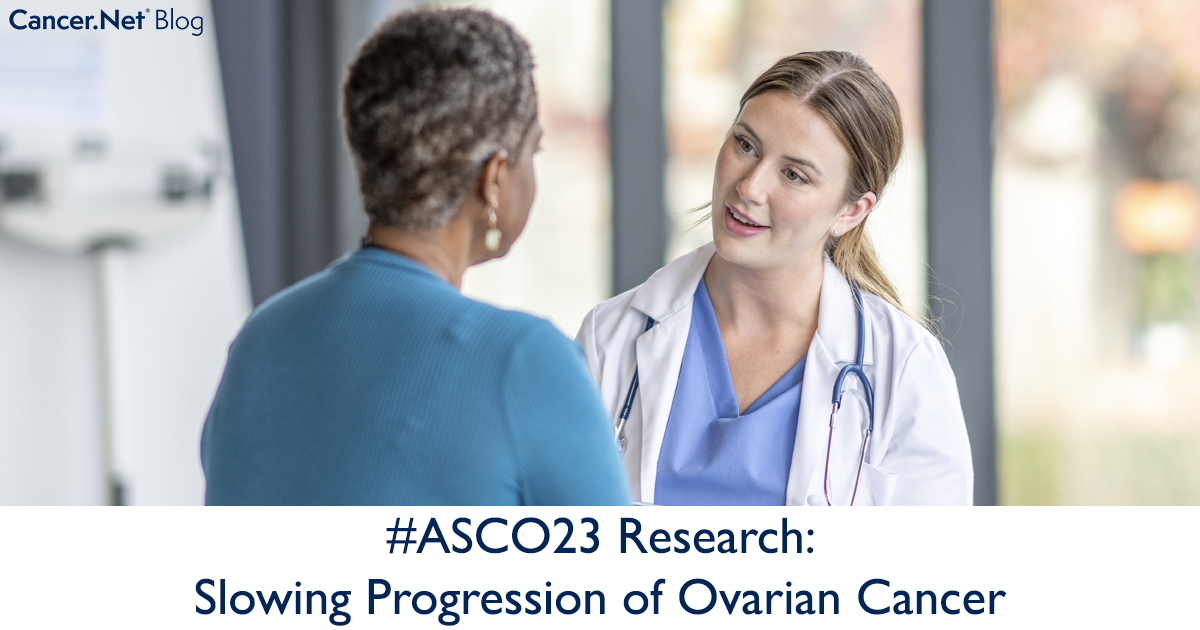
The theme of the 2023 American Society of Clinical Oncology (ASCO) Annual Meeting is Partnering With Patients: The Cornerstone of Cancer Care and Research. From June 2 to 6 in Chicago, Illinois, and online, cancer researchers and clinicians from around the world will gather to discuss the latest research and how to ensure that all people receive the cancer care they need.
ON THIS PAGE
One of the studies that will be presented today explores improving treatment for advanced ovarian cancer:
Adding durvalumab and olaparib to standard treatment delays cancer growth for people with advanced ovarian cancer
Who does this study affect: People with newly diagnosed, advanced, high-grade epithelial ovarian cancer that does not have a BRCA mutation.
What did this study find: The phase 3 DUO-O clinical trial found that adding the immunotherapy drug durvalumab (Imfinzi) and the targeted therapy drug olaparib (Lynparza) to standard treatment for people with newly diagnosed, advanced, high-grade epithelial ovarian cancer without a BRCA mutation delayed cancer growth and reduced their risk of death.
Epithelial cancer makes up 85% to 90% of ovarian cancers. More than two-thirds of people with ovarian cancer are diagnosed with advanced disease, which can grow and spread quickly. The current standard treatment for people with advanced disease is chemotherapy combined with the targeted therapy drug bevacizumab (Avastin), followed by maintenance therapy with bevacizumab. Bevacizumab is a type of targeted therapy called anti-angiogenesis therapy that works by stopping the process of making new blood vessels and “starving” the tumor of the nutrients that would be delivered by those blood vessels. Maintenance therapy is treatment given to reduce the risk of recurrence or delay cancer growth.
Durvalumab is a type of immunotherapy that works by targeting PD-1, allowing the immune system to better find and attack the cancer. Olaparib is a type of targeted therapy called a poly ADP-ribose polymerase (PARP) inhibitor that can slow or stop tumor growth by blocking an enzyme involved in repairing damaged DNA. PARP inhibitors such as olaparib have been used for women with ovarian cancer with a BRCA mutation, and it has also been shown to be effective in those with ovarian cancer with homologous recombination deficiency (HRD). Cancer with HRD has difficulty repairing DNA damage. People whose cancer has HRD typically have better outcomes than those whose cancer does not have HRD. In this study, researchers wanted to learn whether adding durvalumab and olaparib to standard treatment for people with advanced ovarian cancer could help delay cancer growth, regardless of whether the cancer had HRD.
This international study included 1,130 people with stage III or IV, high-grade epithelial ovarian cancer without a BRCA mutation. Participants had either already received or were planning to receive surgery and 1 cycle of chemotherapy with or without bevacizumab. Nearly 40% of the participants had cancer with HRD. For the second cycle of treatment, study participants were randomly assigned to receive 1 of 3 treatments:
-
Treatment arm 1: Current standard treatment of chemotherapy with bevacizumab followed by maintenance therapy with bevacizumab (378 participants)
-
Treatment arm 2: Chemotherapy with bevacizumab and durvalumab followed by maintenance therapy with bevacizumab and durvalumab (374 participants)
-
Treatment arm 3: Chemotherapy with bevacizumab and durvalumab followed by maintenance therapy with bevacizumab, durvalumab, and olaparib (378 participants)
The study found that those who received treatment in arm 3 saw a significant delay in cancer growth compared with those in arm 1, including for those whose cancer did not have HRD. The treatment in arm 3 delayed cancer growth for a median of 37.3 months, compared with 23 months in arm 1 for those whose cancer had HRD. Across all participants, cancer growth was delayed for a median of 24.2 months in arm 3 versus 19.3 months in arm 1. The median is the midpoint, meaning half of the participants experienced cancer growth sooner and half experienced it later.
At 18 months, among those whose cancer had HRD, 84% of participants in arm 3 had not experienced cancer growth compared with 69% of those in arm 1. Across all participants at 18 months, 71% of those in arm 3 had not experienced cancer growth compared with 55% of those in arm 1.
Overall, adding durvalumab and olaparib to standard treatment reduced the risk of death by 51% for those whose cancer had HRD and by 37% for all participants compared with those who received standard treatment.
The researchers found longer delays in cancer growth among the participants who received the arm 2 treatment compared to arm 1 results, but there was not enough evidence to prove that the treatment regimen was more effective than that of arm 1. The researchers will continue to watch these participants to see if the arm 2 treatment is more beneficial than the current standard treatment.
Serious side effects occurred at similar rates in all 3 treatment arms, with 34% of those in arm 1, 43% of those in arm 2, and 39% of those in arm 3 experiencing serious side effects.
What does this mean for patients? Adding durvalumab and olaparib to standard treatment for people with newly diagnosed advanced high-grade epithelial ovarian cancer that does not have a BRCA mutation may help delay cancer growth and reduce the risk of death, including for those whose cancer does not have HRD.
“While there has been significant progress for patients with advanced ovarian cancer, an unmet need still remains. Our trial results provide encouraging evidence that we can find new treatment approaches for patients with advanced disease.”
— Philipp Harter, MD, PhD
Evangelische Kliniken Essen-Mitte Hospital
Essen, Germany
Stay Informed
Visit the Cancer.Net Blog each day of the meeting for more scientific highlights from the 2023 ASCO Annual Meeting and how the new research will affect patient care. You can also keep up with the meeting’s news by following Cancer.Net on Facebook and Twitter, where you can follow the #ASCO23 hashtag.
Like what you’ve read here at Cancer.Net? Sign up for our monthly Inside Cancer.Net e-newsletter.





